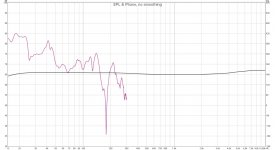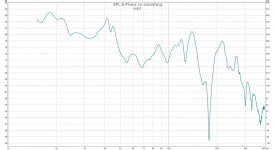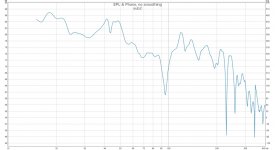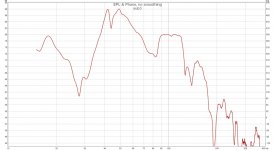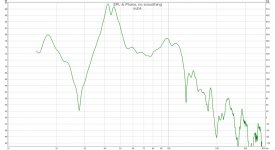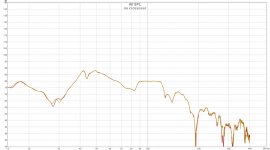beige,
Please tell us what model AV Receiver you are using. Obviously your main speakers are connected to the “front” amplifier L/R output channels (the binding posts) but your subs are probably running off of the RCA line level “sub out.” Are you splitting it, or are you daisy chaining from one sub to the next?
Can you prove beyond a reasonable doubt that the SIGNAL that is being sent to the RCA “sub” output inside the AV Receiver is NOT under the influence of any signal processing (regardless of what the onscreen menu says?). How do you know? You have to measure it (and I am not sure if you have the equipment to check that, like Audio Precision or similar).
Do you have RCA line level outputs for the front channels? I bet they are getting a full range signal. So this might be an option for you.
A picture of the back of your AV Receiver along with the model number may help us.
We want no filters, no EQ, no crossovers (no HP or LP), no delays, etc...on the RCA line level sub output. First, we want a full range signal sent to the subs. Are you sure the plate amplifiers on the subs are also NOT manipulating the signal? Are they “direct” as well?
But first you need to have a full range signal. At the worst, to completely eliminate the room, take one of the subs outside along with your AV Receiver. Put the mic on the ground and do a ground plane measurement from 10Hz to 1khz. Prove that the AVR or the plate amplifier is not manipulating the signal other than gain. I realize you can do a nearfield measurement in room. But in some rooms, even with the mic being within a few cm from the center of the cone of the subwoofer, one can see modal issues in the measurement. Taking the sub outside is one option (several meters from boundaries, of course).
Earl is right, the modal region extends over a wide range, so you need to have at least one sub playing in the > 100Hz range. Don’t worry, you won’t know where it is after everything is set up right. You should not be able to localize any of the subs if you do the procedure properly.
Best,
Anand.
Please tell us what model AV Receiver you are using. Obviously your main speakers are connected to the “front” amplifier L/R output channels (the binding posts) but your subs are probably running off of the RCA line level “sub out.” Are you splitting it, or are you daisy chaining from one sub to the next?
Can you prove beyond a reasonable doubt that the SIGNAL that is being sent to the RCA “sub” output inside the AV Receiver is NOT under the influence of any signal processing (regardless of what the onscreen menu says?). How do you know? You have to measure it (and I am not sure if you have the equipment to check that, like Audio Precision or similar).
Do you have RCA line level outputs for the front channels? I bet they are getting a full range signal. So this might be an option for you.
A picture of the back of your AV Receiver along with the model number may help us.
We want no filters, no EQ, no crossovers (no HP or LP), no delays, etc...on the RCA line level sub output. First, we want a full range signal sent to the subs. Are you sure the plate amplifiers on the subs are also NOT manipulating the signal? Are they “direct” as well?
But first you need to have a full range signal. At the worst, to completely eliminate the room, take one of the subs outside along with your AV Receiver. Put the mic on the ground and do a ground plane measurement from 10Hz to 1khz. Prove that the AVR or the plate amplifier is not manipulating the signal other than gain. I realize you can do a nearfield measurement in room. But in some rooms, even with the mic being within a few cm from the center of the cone of the subwoofer, one can see modal issues in the measurement. Taking the sub outside is one option (several meters from boundaries, of course).
Earl is right, the modal region extends over a wide range, so you need to have at least one sub playing in the > 100Hz range. Don’t worry, you won’t know where it is after everything is set up right. You should not be able to localize any of the subs if you do the procedure properly.
Best,
Anand.
Last edited:
You guys are really thorough and I like that!
Last month I measured each sub separately. Close range measurement in the room (using LFE RCA outputs). I believe I wasn't as accurate as I should be. The mic was placed 6 cm from the cone. But it should be closer, at 1/11 lenght of woofer diameter, which means I should place it 3,5 cm from the cone. Probably that's why the plot isn't as flat as it should be. But it proves there is no 80 Hz high pass filter, right?

These dips at 45 and 90-100 Hz look like room modes, what do you think?
My AVR (not THX certificated - hence no THX filter) has preouts so I can also check these but I doubt it would make a difference. I could also use direct connection from a laptop to a subwoofer using jack-RCA cable and feed it with tones using REW tone generator. In case plots would be similar to the one above I don't see the need to take the sub outside.
Last month I measured each sub separately. Close range measurement in the room (using LFE RCA outputs). I believe I wasn't as accurate as I should be. The mic was placed 6 cm from the cone. But it should be closer, at 1/11 lenght of woofer diameter, which means I should place it 3,5 cm from the cone. Probably that's why the plot isn't as flat as it should be. But it proves there is no 80 Hz high pass filter, right?
These dips at 45 and 90-100 Hz look like room modes, what do you think?
My AVR (not THX certificated - hence no THX filter) has preouts so I can also check these but I doubt it would make a difference. I could also use direct connection from a laptop to a subwoofer using jack-RCA cable and feed it with tones using REW tone generator. In case plots would be similar to the one above I don't see the need to take the sub outside.
Last edited:
I suppose because it was measured at listening position and that's why I think room is causing this.In your previous REW plot, how do you explain a 50dB drop in the response from 100Hz to 300Hz?
4th measurement (post #2173) is sub 3, placed behind listening position.
How does the 4 sub plot look to you? No evidence of crossover, right?
beige,
I completely disagree - there IS evidence of a crossover. If you are not willing to take your subs outside, I want you to place the mic within 1 cm of the center of the cone of only ONE subwoofer (the subwoofer being tested) and measure the frequency response you are getting from 10Hz all the way to 500+ hz.
Repeat the same measurement for your other subs. Do not have your main speakers running. Disconnect their speaker cables.
For some reason I feel as if you are not understanding the problem we are seeing in your response curves.
Best,
Anand.
I completely disagree - there IS evidence of a crossover. If you are not willing to take your subs outside, I want you to place the mic within 1 cm of the center of the cone of only ONE subwoofer (the subwoofer being tested) and measure the frequency response you are getting from 10Hz all the way to 500+ hz.
Repeat the same measurement for your other subs. Do not have your main speakers running. Disconnect their speaker cables.
For some reason I feel as if you are not understanding the problem we are seeing in your response curves.
Best,
Anand.
I agree with Anand. Your subs have to have some kind of LP filter to drop at such a rapid rate. Rooms don't do that and neither do speakers. Only electroinic can cause that fast of a drop.
And if you consider the +- 3 dB spec that you quoted, the - 3 dB point, from the peak level, is at about 80 Hz, not 120 Hz.
Don't get us wrong, you can use these subs as they are, it would just be better if they didn't have an existing LP in them as this will compromise the results, especially in the range > 80 Hz. since then there aren't really any subs in that region to help out.
And if you consider the +- 3 dB spec that you quoted, the - 3 dB point, from the peak level, is at about 80 Hz, not 120 Hz.
Don't get us wrong, you can use these subs as they are, it would just be better if they didn't have an existing LP in them as this will compromise the results, especially in the range > 80 Hz. since then there aren't really any subs in that region to help out.
Yes it is.
So you are suggesting first sub should not have any LPF for better blending and other two/three should be low-passed in critical areas?
It might be a language problem, but I don't think that I ever suggested that. The LP filters need to be part of the solution and no one can say apriori where they should be. The specifics will tell us that as we proceed. But if there already are LP filters that cannot be disabled, then you have a highly constrained situation that will not come out optimally.
My bet is that they are in the plate amps on the subs. That will be a problem.
It might be a language problem... But if there already are LP filters that cannot be disabled, then you have a highly constrained situation that will not come out optimally.
My bet is that they are in the plate amps on the subs. That will be a problem.
I believe beige had said that the subs were designed by Velodyne who may have an LP filter built into the plate amps. Again, I would like to get information on the AV Receiver and Velodyne subwoofer to discover which one or perhaps both are causing the issue we see.
Another option for beige, is to either use his laptop direct to the subwoofer LFE or use a separate preamp, to rule out the AVR as the source of the problem. If you see the same issue when you run your REW measurement, the problem is then with your plate amp of your subs. The only way to solve that problem are new, well designed plate amps (like Hypex for example) that are eminently flexible and do not have bandwidth filters. Or a new subwoofer design with a separate Minidsp and separate amplifiers for the subs. I am sure there are other options, like Behringer DCX2496, etc...
The ball is back is in your court beige!
Best,
Anand.
OMG.
I owe you all a big apology!
You were all of course right.
I finally figured it out.
Marantz processors/receivers have pure direct option. I was under the impression this bypasses all the settings (except delay which may be useful).
Even if it would not, there is a speaker size setting. It was set to large so no crossover should be engaged. However, even when set to large, the crossover is somehow active. That's weird and I have never seen something like that.
I set the crossover to 250 Hz and here is the graph from front sub.
Again, I'm sorry for the confussion, this was really unexpected but yet I'm happy that you proved me wrong! I almost took the sub out of the room and bring my old laptop under the couch.
I owe you all a big apology!
You were all of course right.
I finally figured it out.
Marantz processors/receivers have pure direct option. I was under the impression this bypasses all the settings (except delay which may be useful).
Even if it would not, there is a speaker size setting. It was set to large so no crossover should be engaged. However, even when set to large, the crossover is somehow active. That's weird and I have never seen something like that.
I set the crossover to 250 Hz and here is the graph from front sub.
Again, I'm sorry for the confussion, this was really unexpected but yet I'm happy that you proved me wrong! I almost took the sub out of the room and bring my old laptop under the couch.
Attachments
You could also use the front preouts with the Fronts set to large and no sub selected in the AVR, which should give you a full range signal.
Indeed, I mentioned that in post 2184 of this thread.
Best,
Anand
Last edited:
beige,
Deselect the mic/meter cal button on the bottom of the graph so we don't see that black line. Set the Limits (right upper hand section of REW) to a 50dB vertical scale (like 45 to 95dB) and the Left Hz to 20Hz and Right Hz to 400Hz. No smoothing. Repost the graph to this thread.
Do that measurement systematically for your other 3 subs and post them together to this thread. I would also set your 'crossover' to 500Hz so we can see more of the subs response curves.
Then we can try to give you advise on which sub you need to work with first.
Best,
Anand.
Deselect the mic/meter cal button on the bottom of the graph so we don't see that black line. Set the Limits (right upper hand section of REW) to a 50dB vertical scale (like 45 to 95dB) and the Left Hz to 20Hz and Right Hz to 400Hz. No smoothing. Repost the graph to this thread.
Do that measurement systematically for your other 3 subs and post them together to this thread. I would also set your 'crossover' to 500Hz so we can see more of the subs response curves.
Then we can try to give you advise on which sub you need to work with first.
Best,
Anand.
Thank you, Anand!
Here is goes.
Crossover is set to 250 Hz. Unfortunately I can't set it higher.
Subs 3 and 4 can be slightly moved or turned around - in case it would help. I can try some near locations and see what happens.
Here is goes.
Crossover is set to 250 Hz. Unfortunately I can't set it higher.
Subs 3 and 4 can be slightly moved or turned around - in case it would help. I can try some near locations and see what happens.
Attachments
I would certainly move the subs around as much as you can and repeat a few more measurements. Remember you want to start with the flattest measuring sub. Unfortunately, even though you were able to move the low pass filter to 250Hz, it still serves as an impasse, although not as big as it once was. One option is if you have front RCA outputs (that do not have any filters linked to that output), connect that to a minidsp module so that your 4 subs can be addressed without the encumbrance of filters existent in your AVR.
But yes, like all of us, you have room modes, and modal ringing which can be addressed. Sub 1 and Sub 2 complement each other, so I would try hard to move Sub 3 and Sub 4 as they are certainly not as flat appearing as Sub 1/2.
Best,
Anand.
But yes, like all of us, you have room modes, and modal ringing which can be addressed. Sub 1 and Sub 2 complement each other, so I would try hard to move Sub 3 and Sub 4 as they are certainly not as flat appearing as Sub 1/2.
Best,
Anand.
OK, I found a way to disable the crossover.
2ch Playback SR7009
It says here that setting SW mode to LFE (instead of LFE+Main) disables the crossover.
Here are sub3 comparison plots: 250 Hz crossover and full-band. No big difference.
I will now try to move subs 3 and 4 and see if there will be any improvement.
I'm glas subs 1 and 2 complement each other as there is not enough space to move them around.
2ch Playback SR7009
It says here that setting SW mode to LFE (instead of LFE+Main) disables the crossover.
Here are sub3 comparison plots: 250 Hz crossover and full-band. No big difference.
I will now try to move subs 3 and 4 and see if there will be any improvement.
I'm glas subs 1 and 2 complement each other as there is not enough space to move them around.
Attachments
- Home
- Loudspeakers
- Subwoofers
- Multiple Small Subs - Geddes Approach
